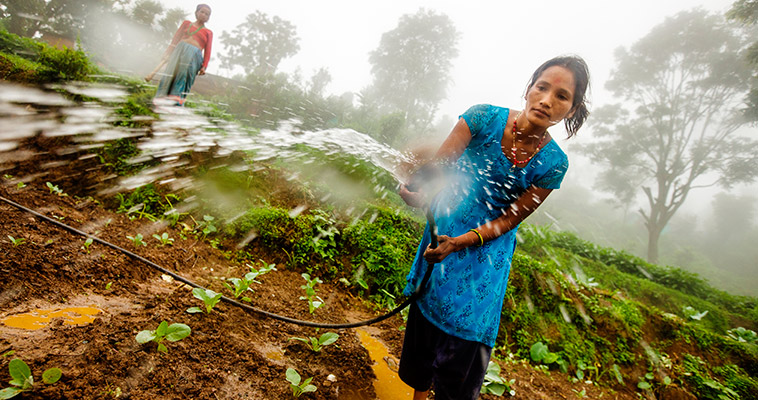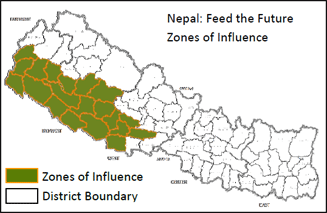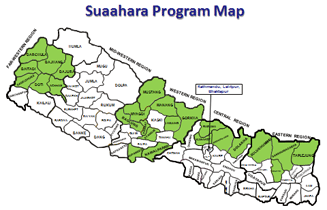
-
Nepal

-
Population
30 Million
-
Pop. Under 5
3.1 Million
-
% Stunting
41% Of Children Under 5
-
% Underweight
29% Of Children Under 5
Photo credit: Fintrac Inc.
At a Glance
- Background
- Nutrition Situation
- USAID Programs: Accelerating Progress in Nutrition
- Other USAID Nutrition-Related Development Assistance
Download the nutrition profile [PDF, 370KB]
Background
Landlocked between India and China, Nepal is among the poorest countries in the world—55 percent of its population lives below the poverty line1—and it ranks 145th out of 187 countries on UNDP’s 2014 Human Development Index. The country is going through a prolonged transition to peace and stability after twenty years of political instability and ten years of violent conflict that ended in 2006, with a peace agreement between the Maoists and the Government.
Nepal faces many challenges to economic growth and human development, including poor access to power, the lowest road density in South Asia, high susceptibility to climate change, vulnerability to earthquakes, and weak governance2. The agricultural sector employs 80 percent of the population but accounts for only 38 percent of GDP1 and growth is constrained by low productivity and limited market access.
Despite protracted political instability, Nepal is likely to achieve most of its MDG targets, including halving extreme poverty, reducing child mortality by two-thirds, and improving maternal health by more than two thirds. Nepal has cut its rates in infant, under-five, and maternal mortality roughly in half since 19963, a major feat for a struggling, low-income country.
Nutrition Situation
Stagnant growth and political instability have contributed to acute food shortages and high rates of undernutrition, mostly affecting vulnerable women and children in the hills and mountains of the mid- and far-western regions. Though rates of stunting and underweight have decreased and the rate of exclusive breastfeeding has increased in the past seven years, 41 percent of children under five remain stunted,4 a rate that increases to 60 percent in the western mountains.5 Children in food-secure households have the lowest rates of stunting (33 percent), while children in food-insecure households have rates up to 49 percent.4
Maternal education and socio-economic status have an inverse relationship with childhood stunting. Micronutrient deficiencies are widespread, with almost half of pregnant women and children under five, as well as 35 percent of women of reproductive age being anemic.4,6 Only 24 percent of children consume iron-rich food, 24 percent of children meet a minimally acceptable diet, and only half of pregnant women take recommended iron supplementation during pregnancy.4 A contributing factor to deteriorating nutrition is high diarrheal disease morbidity, exacerbated by the lack of access to proper sanitation and the common practice of open defecation (44 percent) in Nepal.
| Nepal Nutrition Data | ||
|---|---|---|
| Population (2012) | 30 million | |
| Population under 5 years of age (0-59 months, 2012) | 3.1 million | |
| DHS 20066 | DHS 20114 | |
| Prevalence of stunting among children under 5 (0-59 months) | 49% | 41% |
| Prevalence of underweight among children under 5 (0-59 months) | 39% | 29% |
| Prevalence of wasting among children under 5 (0-59 months) | 13% | 11% |
| Prevalence of anemia among children aged 6-59 months | 48% | 46% |
| Prevalence of anemia among women of reproductive age (15-49 years) | 36% | 35% |
| Prevalence of thinness among women of reproductive age (15-49 years) | 24% | 18% |
| Prevalence of children aged 0-5 months exclusively breastfed | 53% | 70% |
| Prevalence of breastfed children aged 6-23 months receiving a minimum acceptable diet | N/A | 24% |
National Nutrition Policies
Government initiatives have been underway for more than three decades with national nutritional strategies developed in 1978, 1986, 1998, and 2004. A Multi-Sectoral Nutrition Plan (MSNP) 2013-2017 serves as a common results framework for improving nutrition outcomes; and setting out plans of action for implementing nutrition-sensitive policies and strategies for key sectors, including agriculture and food security, public health, and education. Its objectives are to reduce the prevalence of stunting among children under five to below 29 percent, to reduce the prevalence of underweight to below 20 percent; to reduce the prevalence of wasting among children under five to below 5 percent, and to reduce under-nutrition among women 15–49 years of age (BMI<18.5kg/m2) by 15 percent.
In 2011, Nepal joined Scaling Up Nutrition (SUN), a global movement that unites national leaders, civil society, bilateral and multilateral organizations, donors, businesses, and researchers in a collective effort to improve nutrition. The World Bank is the donor convener for SUN in Nepal. SUN’s priority commitments in Nepal are to implement and scale up evidence-based, cost-effective nutrition-programs of the MSNP; develop and implement a long-term National Food Security and Nutrition Action Plan; strengthen key sectors to implement the MSNP and National Food Security and Nutrition Plan; and strengthen monitoring of MSNP implementation, with links to existing food security early warning systems. In addition, the SUN Multi-Partner Trust Fund recently funded civil society organizations (CSOs) to establish a sustainable and inclusive civil society alliance on nutrition.
USAID Programs: Accelerating Progress in Nutrition
| Highlighted Bilateral Nutrition Projects in Nepal | ||||
|---|---|---|---|---|
| Project Name | Year Awarded | End Date | Objective(s) | |
| Suaahara (Integrated Nutrition Project) | 08/2011 | 8/2016 | Reduce the national stunting prevalence rate from 41 percent to 27 percent. | |
| Knowledge-Based Integrated Sustainable Agriculture and Nutrition (KISAN) | 02/2013 | 02/2018 | Reduce poverty and hunger in Nepal by achieving inclusive growth in the agriculture sector, increasing income of farm families and improving nutritional status, especially of women and children. | |
Feed the Future Progress
Feed the Future, the U.S. Government’s global hunger and food security initiative, recognizes the need to build resilience among vulnerable populations in response to changing climates, low agricultural productivity, weak market linkages, poor extension services, rising food prices, and inadequate consumption of nutritious foods. The strategy is made up of three separate, but mutually reinforcing, components: small-scale commercial agriculture, nutrition and hygiene capacity building, and combined literacy and entrepreneurship. Feed the Future targets 20 districts in the Hill and Terai areas of the Far-West, Mid-West, and West regions, which were selected based on poverty and hunger indexes, sales of household assets due to food insecurity, male and youth outmigration, prevalence of female-headed households, and potential for returns on investment.
USAID/Nepal: Feed the Future Goals for 2017
- Reduce the prevalence of poverty in Feed the Future target regions by 28 percent
- Reduce the prevalence of stunting in Feed the Future target regions by 20 percent
Feed the Future’s flagship integrated project, Knowledge-Based Integrated Sustainable Agriculture and Nutrition (KISAN) aims to reach up to one million rural Nepalese by working with 160,000 farm households, pregnant and lactating women, and children under two. To scale up small-scale commercial agriculture, KISAN will use private service providers, agribusinesses, government extension agents, and leading farmers as ‘change agents’ to promote the adoption of conservation agricultural packages, a variety of soil and water management techniques, and community production of climate-adapted seeds. Training on micro-dams, fish farming, linkage strategies to markets, and creating farmer cooperatives will also be provided. Nutrition interventions will be delivered through female community health volunteers, mother’s groups, and Peace Corps Volunteers, who will deliver messages on essential nutrition and hygiene actions (ENA/EHA), and infant feeding practices. Household gardening and improved knowledge on diet and behavior change messages will target both men and women.
Two Feed the Future agriculture/economic growth initiatives, Nepal Economic Agriculture and Trade Activity (NEAT) and Hill Maize Research Project (HMRP), are programmatically linked to KISAN. The Education for Income Generation (EIG) project serves as a model for the upcoming Feed the Future project on literacy and entrepreneurship, which will target the most vulnerable populations in terms of gender, caste, and poverty; with life skills, literacy, and vocational training.

Other USAID Nutrition-Related Development Assistance
USAID funds Suaahara (‘Good Nutrition’) to improve the health and nutritional status of pregnant and lactating women, and children under two years of age through an integrated approach. It aims to directly address the vulnerable points of development, which can result in chronic undernutrition. The project focuses on improving: nutrition; maternal, newborn, and child health (MNCH) services; reproductive health/family planning services; water, sanitation and hygiene; and home-based gardening.
It is not under the Feed the Future portfolio, but shares critical geographic, programmatic, and technical links with Feed the Future. The project works within the government system, primarily through Female Community Health Volunteers (FCHVs) and other community extension workers. FCHVs disseminate critical health messages, services, and commodities at the household level and through mothers’ group discussion forums. They also use home food production and village-model farm techniques to promote better access to nutritious foods.

Health facility capacity building includes training on growth monitoring, infant and young child feeding counseling, nutrition education, and micronutrient supplementation. Like KISAN, Suaahara taps into existing networks to provide health and nutrition education to community members and to reinforce referrals to health centers.
Suaahara is considered to be an innovative approach to comprehensive, community-based integrated nutrition programs, having the potential to be replicated in other settings. In FY2012, Suaahara provided 7,691 people, including 48,000 community health workers, with introductory and refresher nutrition training. It also mobilized community health workers for the biannual vitamin A supplementation of children 6 months to 5 years old, exceeding their intended target. Suaahara also collaborated with the Ministry of Health and Population to develop a maternal and child health training manual.7
Nepal is one of the first eight countries to be selected for the Global Health Initiative’s "GHI Plus", which will provide additional technical and management support to quickly implement GHI’s approach, including integrated programs and investments across the spectrum of infectious diseases, maternal and child health, family planning, and health systems activities.8 In FY2012, the USG supported formative research on nutrition in Nepal in order to design critical interventions and communication strategies for GHI and Feed the Future programs targeting chronic malnutrition.7
The Office of Food for Peace (Title II) works in partnership with the World Food Program in Nepal and targets approximately 183,600 food-insecure Nepalese and 6,650 Bhutanese refugees, providing direct general distribution, food for assets, and supplementary feeding.9
Nepal joined the Committing to Child Survival: A Promise Renewed campaign in 2012 and pledged to reduce under-five mortality to 20 or fewer deaths per 1,000 live births by 2035 by reducing the leading preventable causes of child mortality, including undernutrition. To view the country action plan for ending preventable child and maternal deaths in Nepal, please see the Acting on the Call 2014 report [PDF, 14.2MB].
References
- Feed the Future Nepal country page
- World Bank Nepal Country Overview
- UNDP Nepal’s Progress on the MDGs
- Nepal Demographic and Health Survey 2011. Population Division, MoHP and New ERS, Nepal & ICF International, Calverton, MD, USA.
- Nepal Thematic Report on Food Security and Nutrition 2013, National Planning Commission Central Bureau of Statistics.
- Nepal Demographic and Health Survey 2006. Population Division, MoHP and New ERS, Nepal & ICF International, Calverton, MD, USA.
- Nepal Mission Full Performance Plan Report, 2012. USAID.
- PEPFAR Fiscal Year 2010 Operational Plan, 2011.
- Food Assistance Fact Sheet- Nepal







Comment
Make a general inquiry or suggest an improvement.